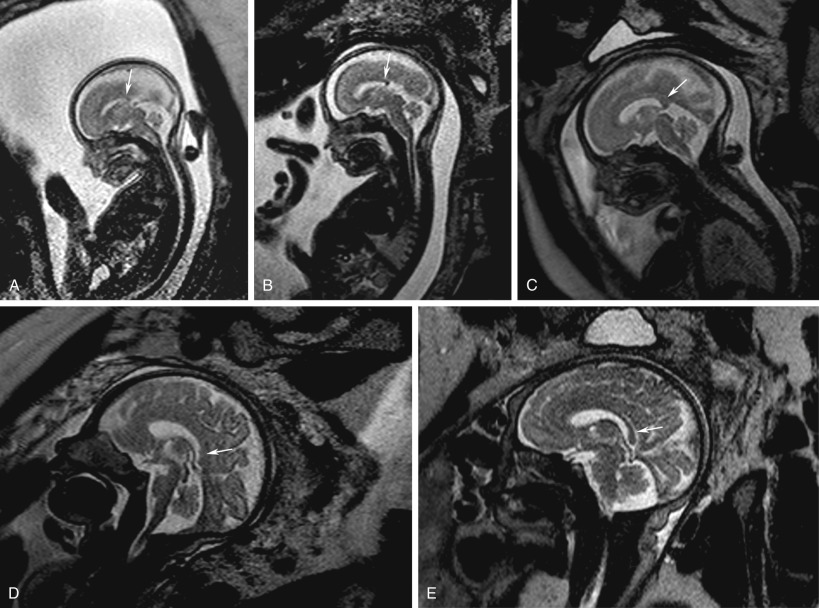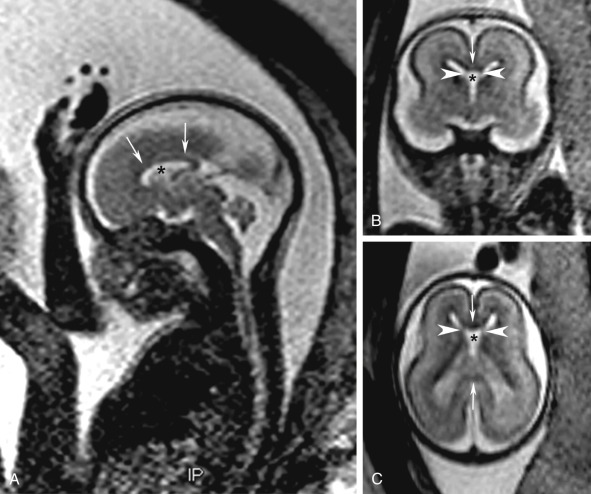Abstract
Anomalies of the corpus callosum (ACC) and septum pellucidum are disorders of prosencephalic midline development, which are often associated with other brain abnormalities or may be part of a syndrome.
Diagnosis of ACC is usually impossible before 18 to 20 weeks’ gestation because the formation of the corpus callosum is incomplete. ACC can be complete or partial.
The main indirect US signs of complete ACC include colpocephaly, absent CSP, and increased separation of the hemispheres. The definitive diagnosis relies on the demonstration of the absence of the corpus callosum on midsagittal and coronal views of the fetal brain. Partial ACC could be difficult to identify as in 1/3 of the cases there are no indirect signs. Fetal magnetic resonance imaging (MRI) is more sensitive than US in the recognition of possible associated cerebral anomalies.
The overall prognosis of ACC is controversial and may range from asymptomatic with normal intellectual capacities to severe mental retardation. Several studies have reported a worse prognosis in the presence of additional anomalies. Cases of isolated ACC seem to have a better prognosis.
Absence of the septum pellucidum can be diagnosed by US in the second trimester of pregnancy.
Some associated brain abnormalities are not detectable before the third trimester, and in most cases it is impossible to determine the presence of SOD before birth.
MRI can visualize the size of the optic nerves and chiasma (in late pregnancy) to search for optic nerve or chiasma hypoplasia (SOD) and to show possible associated cortical abnormalities (SOD-plus).
Clinical severity of ASP varies, and only 30% of patients manifest the complete clinical triad. Children with isolated ASP have a favorable neurological outcome, but 18% of fetuses diagnosed with ASP are at risk for SOD.
Keywords
agenesis of corpus callosum, cavum septum pellucidum, fetal MRI, septooptic dysplasia
Introduction
Anomalies of the corpus callosum and septum pellucidum are disorders of prosencephalic midline development. Midline prosencephalic development peaks at 7 to 12 weeks’ gestation and includes the formation of the chiasmatic, commissural, and hypothalamic plates, enabling formation of the corpus callosum (12 to 20 weeks) and septum pellucidum. Corpus callosum and septum pellucidum anomalies are often associated with other brain abnormalities.
Corpus Callosum Anomalies
Definition
The corpus callosum represents the major telencephalic commissure. The telencephalic commissures are corticocortical bundles of white matter extending from one hemisphere to the other, typically in a symmetric fashion. The other interhemispheric commissures are the anterior and the hippocampal commissures. The corpus callosum is composed of four parts (from front to back): rostrum, genu, body, and splenium ( Fig. 34.1 ). Developmental abnormalities of the corpus callosum include complete or partial agenesis of the corpus callosum (ACC); partial ACC is also referred to as hypogenesis (or dysgenesis ).
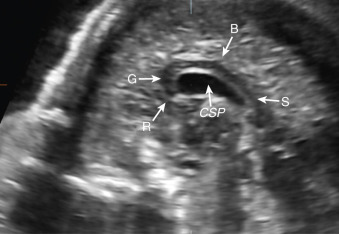
Prevalence and Epidemiology
The prevalence of corpus callosum anomalies varies significantly in different studies. Depending on the population and the diagnostic criteria, 0.3% to 0.7% in the general population and 2% to 3% in developmentally disabled individuals have been reported.
Etiology and Pathophysiology
The anterior part of the corpus callosum develops along a fusion line composed of specialized groups of glial cells, the glial sling, that guide commissural axons of the frontal lobes through the interhemispheric meninges toward the contralateral hemisphere. Commissural fibers from the temporooccipital lobes cross the midline along the anterior commissure, while posterior occipitoparietal fibers cross along the scaffold provided by the hippocampal commissure, resulting in the callosal splenium. Thus, contrary to common misconception, there is no anteroposterior growth of the corpus callosum; rather the corpus callosum forms by two separate segments that eventually coalesce to fuse the complete commissural plate. If the normal developmental process is disturbed, the corpus callosum may be completely or partially absent (hypogenetic).
The knowledge of the organogenetic process helps differentiate a developmental injury (hypogenesis) from an acquired one (destruction). The latter mechanism usually occurs in association with hypoxic-ischemic injury and infectious causes. Two types of congenital callosal abnormalities can then be distinguished. In the first type, the axons are present but are unable to cross the midline; they form large aberrant fiber bundles (“Probst bundles”) along the medial hemispheric walls. In the second type, which is less frequent, the axons fail to form, and no Probst bundles are found. The etiology of ACC is very heterogeneous. Identified causes are chromosomal, monogenic, and teratogenic. Chromosomal abnormalities are present in 20% of ACC, especially trisomies 18 and 13. More than 250 syndromes involving ACC have been reported and about 15 genes have been identified as responsible for AAC. Some environmental and metabolic factors also have been implicated in ACC, such as fetal cytomegalovirus and rubella infections and fetal alcohol exposure. Most isolated ACC cases are sporadic. However, autosomal recessive or dominant transmission occurs in about 3% (personal data), which may justify magnetic resonance imaging (MRI) assessment of the parents’ corpus callosum.
Manifestations of Disease
Clinical Presentation
Clinical features of ACC include mental retardation, easily controlled epilepsy, and behavioral disorders. Clinical findings vary widely, ranging from asymptomatic with normal intellectual capacities to severe mental retardation.
Although the overall prognosis of ACC is controversial, several studies reported a worse prognosis in the presence of additional anomalies. Cases of isolated ACC seem to carry a better prognosis, but the clinician must be cautious when assessing the fetal and neonatal prognosis considering the small number of fetal series reported in the literature. Even with extensive prenatal analysis it is difficult to ascertain whether the malformation is truly isolated.
A review article was recently dedicated to neurodevelopmental outcome in truly isolated ACC found only six studies using appropriate data (MRI before and after birth, neurodevelopmental assessment with standardized tests). The outcome was favorable in 75.4% of cases, with moderate disability in 13% and severe disability in 11.6% of cases. The prognosis of partially isolated ACC was not significantly different from that of isolated complete forms.
In individuals with ACC, subtle neuropsychologic, perceptual, and motor defects can emerge later in life. Long-term follow-up is important, especially with regard to social interactions and school performance, to provide better prognostic information to families.
Imaging Technique and Findings
Ultrasound.
The corpus callosum can be shown with ultrasound (US), but some degree of technical skill is required because it is not apparent in the standard axial planes, and additional coronal and particularly sagittal planes are required. In fetuses in cephalic presentation, the transvaginal approach is preferred; in fetuses in breech presentation, a transfundal approach is suggested. Using a three-dimensional multiplanar technique can also be helpful because it offers a more accurate identification of the midsagittal plane, and navigation in the other two simultaneous orthogonal planes may permit a better evaluation of the midline prosencephalic structures ( Fig. 34.2 ). In axial planes, the diagnosis is based on the presence of indirect signs. Because the corpus callosum shares a common anatomic and embryogenetic formation with the septum pellucidum, complete ACC is commonly associated with a hypoplastic or absent cavum septi pellucidi (CSP).
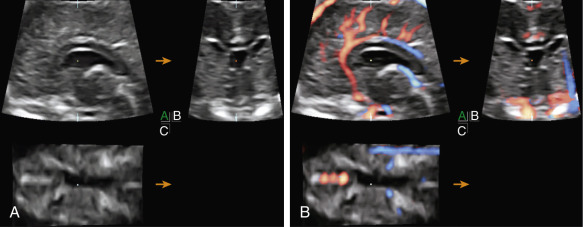
Complete Corpus Callosum Agenesis.
At the second-trimester anomaly scan, ACC may be suspected when the CSP is not visualized on the axial transventricular view ( Fig. 34.3 ). The suspicion of ACC is supported further by the recognition of other indirect signs, such as (1) colpocephaly (dilatation of the atria and occipital horns of the lateral ventricles, owing to the absence of the splenium and to a defect of the intrinsic association bundles of the occipital lobe) ( Fig. 34.4 ) and (2) increased separation of the hemispheres with the bodies of the lateral ventricles parallel to each other and shifted laterally (see Fig. 34.4 ). Dorsal elevation of the third ventricle can be also present. On coronal sections of the fetal brain, the indirect signs are mainly apparent in the frontal horns, which are separated more than usual and show concave medial borders ( Fig. 34.5 ). This appearance is due to the compression exerted by a large longitudinal bundle of fibers representing the callosal fibers that fail to cross the hemispheres, are rerouted parasagittally, and run parallel to the midline. This abnormal bundle, the longitudinal bundle of Probst, runs parallel to the medial walls of the lateral ventricles and enlarges and deforms their medial borders, especially at the level of the frontal horns. Each of these indirect signs can be present in isolation, which in part explains the frequently missed diagnosis of ACC.
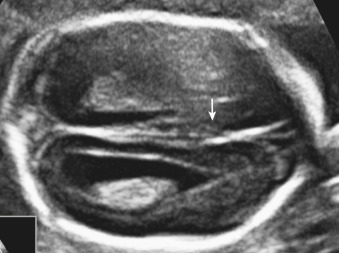
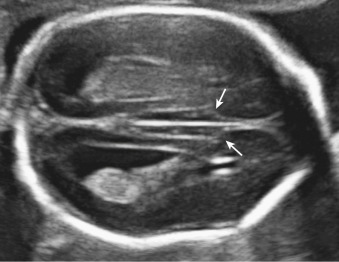
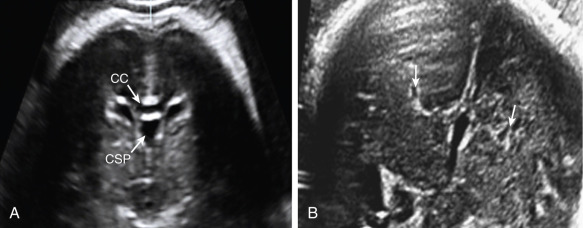
A definitive diagnosis of ACC relies on direct visualization : demonstration of the absence of the corpus callosum on midsagittal and coronal views of the fetal brain. In particular, the midsagittal plane shows absence of the corpus callosum ( Fig. 34.6A ) and, in advanced gestation or postnatally, an atypical radiating appearance of the median sulci, which converge toward the third ventricle (see Fig. 34.6B ). In this view, the cingulate gyrus can be recognized, or appears incomplete.
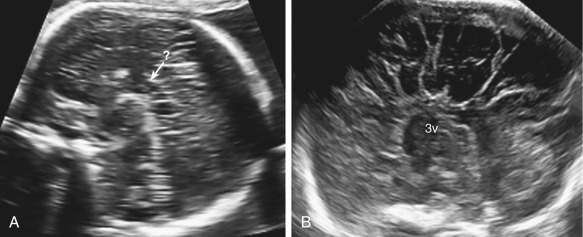
Partial Corpus Callosum Agenesis.
ACC may also be partial (pACC), resulting in more subtle US findings than are associated with complete ACC. When the corpus callosum is incompletely formed, usually the posterior portion is affected (the posterior body and the splenium); in this situation, the CSP can be present, and often the only indirect US sign is colpocephaly. Identifying pACC is important because approximately one third of apparently isolated cases are associated with moderate or severe neurological morbidity. In up to one-third of cases there are no indirect signs, and consequently the diagnosis may be missed unless direct demonstration of the corpus callosum (CC) in the midsagittal plane is attempted. In cases of pACC without indirect signs, the shape of CSP is also abnormal. A sagittal view is the only way to make the diagnosis, visualizing a small corpus callosum that is lacking the posterior part ( Fig. 34.7 ) and only partially surrounds the third ventricle. Less frequently, the remaining structure in pACC is the genu; it can appear thin and barely discernible with grayscale imaging and can be identified only when highlighted by the course of the pericallosal artery.
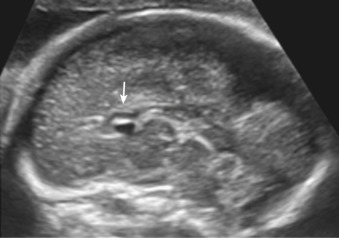
In ACC, color Doppler demonstrates that the normal semicircular arterial loop, formed by the pericallosal artery along the superior surface of corpus callosum, is missing or distorted ( Fig. 34.8 ). This sign may help make the diagnosis of ACC, with even greater value in partial ACC; in partial ACC, the pericallosal artery closely follows and outlines the small anterior part of the corpus callosum, which is difficult to delineate with grayscale imaging alone. In pACC this course is then lost and usually absent in the posterior part of corpus callosum.

Midline interhemispheric cysts associated with ACC are considered extensions of the ventricular system (see Fig. 34.8C ). Intracranial lipoma is another median anomaly that may be associated with ACC. This anomaly is visible only in the third trimester as a hyperechoic structure under the inferior part of the interhemispheric fissure ( Fig. 34.9 ).
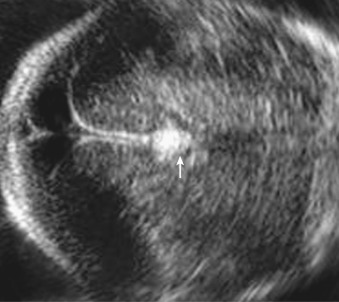
Magnetic Resonance Imaging.
Fetal MRI allows good visualization of the corpus callosum and other midline structures. MRI is usually performed acquiring T2-weighted sequences with ultrafast techniques (such as single-shot fast-spin echo), which provide images without motion artifacts and with good resolution. The normal corpus callosum is displayed as a low-signal intensity stripe arching between the two hemispheres ( Fig. 34.e1 ). The genu and body of the corpus callosum are visible above the CSP, whose splayed leaves are visible on coronal and axial slices. Regardless of the gestational age, the posterior callosal portion (body to splenium) is invariably better seen than the anterior portion (rostrum and genu) ( Fig. 34.10 ) because of the larger degree of separation of the two hemispheres and extension of the interhemispheric fissure posteriorly. Therefore, any evaluation of the commissural plate must also include orthogonal (axial and coronal) slices. The length of the corpus callosum is easily measurable on midsagittal scans; normal ranges across gestation are available ( Fig. 34.e2 ). Standards of corpus callosum thickness by fetal MRI are still lacking.
